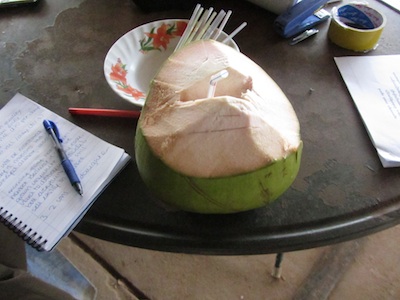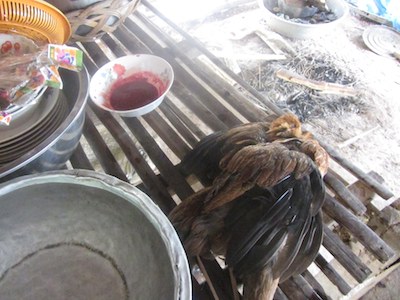Today I spent the afternoon on personal preparations for baseline, and I’m not talking about anything survey-related. I spent the afternoon purchasing non-perishable food to bring with me to Prey Veng.
Before I came to Cambodia, I never thought of myself as a picky eater. There are a few things I don’t like (to say I dislike ketchup is an understatement), but overall I can usually find something to eat. Growing up in Vancouver meant that I was exposed to multicultural cuisine from a young age. I love curry, dim sum, and sushi. My pre-travel research highlighted the prominence of fish, rice, soup, noodles and vegetables in the Cambodian diet. I love fish! I love rice! I thought I was set.
My first trip to Central Market in Phnom Penh was paradigm-shifting, to say the least. It could also be described as an olfactory assault. Before I even noticed what was for sale, I noticed how it smelled. There is an entirely unfamiliar, pungent odor that I now associate with Khmer food. Apparently I have an aversion to fish sauce, which is used in most dishes here as an easy way to enhance both the nutritional value and flavor (and odor) of food.

Outside of Psah Thmei, or Central Market
I forced myself to take in the scene at the market using my eyes rather than my nose. The offerings were more diverse than I expected. There were a lot of things I recognized, but even more that I didn’t. I had expected fish, but I hadn’t expected so many types of fish, prepared in so many different ways. Very few of the vegetables and fruits looked familiar. (I have since tried mangosteen and dragon fruit– yum!). Food that I thought I recognized turned out to be something different. Those hard-boiled eggs weren’t the hard-boiled eggs I’m used to – they were actually hard-boiled eggs with animal fetuses inside, for a little extra crunch. Things that I don’t even consider to be food were sold as food (see below).
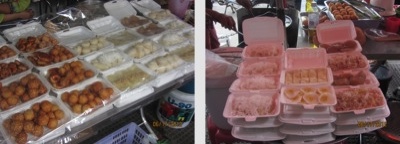
Some of the offerings at Central Market

Left: Skewers of meat Middle: Boiling the skewers Right: Grilled Squid
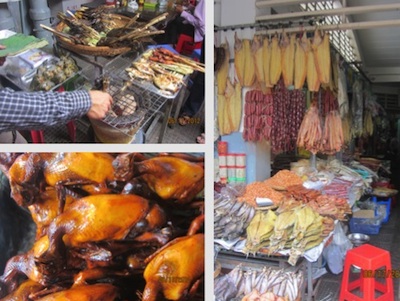
Top left: Several types of fish available for lunch Bottom left: Roasted birds Right: fish and meat to purchase for home
I left the market with the few items I came for: some fruit and a tupperware container.
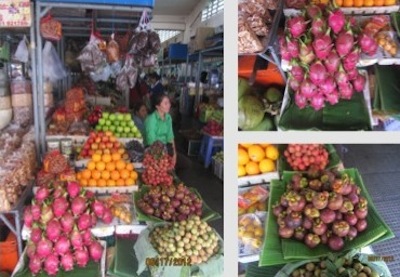
Left: fruit vendor Top right: dragon fruit Bottom right: mangosteen
Tomorrow I’ll stock up at Lucky Market, which sells Western food. On my shopping list: peanut butter, crackers, nuts, and dried fruit.
On my tuk tuk drive home from the market, I tried to process what I had seen and smelled. However, I ended up with more questions than answers. I wondered if a Cambodian person would have the same reaction to a Canadian market as I did to a Cambodian market. What foods at Granville Island would seem foreign or unappetizing to them?
I also wondered when the Western diet became so limited. In North America, it’s extremely rare to eat insects. It’s also unusual to eat all the parts of a fish (although I have seen this done – but usually when fish is on the menu, a boneless filet arrives at the table) or the organs of an animal (again, there are exceptions to this rule). When did we stop eating all the parts of an animal? Why did this happen? Is it because our society, as a whole, is affluent enough to be more selective?
Do Cambodians eat a greater variety of animals and animal parts for nutritional reasons, such as a lack of available Western sources of protein? Or do they eat these things because it’s what they’re raised to eat, so these foods are “normal” to them and are consumed without hesitation?
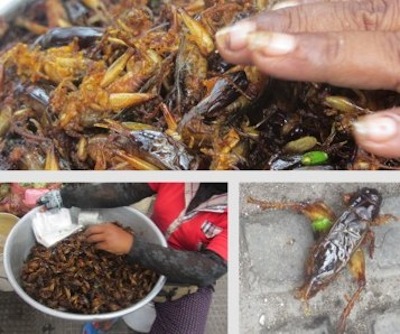
Protein-rich insects for sale
During my undergraduate studies at Barnard College, Columbia University, I took a course entitled “Edible Conflicts: The History of Food.” We discussed how food has shaped society from pre-historic times to the present. I’ve seen examples of this here in Cambodia, from the way people sit around a food stall at a market to enjoy their food and chat with the chef and other patrons (rather than going to a cluster of tables and chairs the way one might at a food court), to the way our survey defines members of a household as people who eat from the same pot in one house.

Eating lunch at the vendor's counter
But now I’m also trying to understand the Cambodian diet from a nutritionist’s perspective. After all, that’s what Fish on Farms is doing. We’re trying to take the Cambodian diet, which has developed along its trajectory due to historical and geographical conditions, and effect change in a culturally-acceptable manner to improve the lives of Cambodians. That’s why we picked aquaculture over chicken coops. Chicken and eggs don’t feature prominently in national diet, whereas fish is front and center.
I’m looking forward to observing several homes in Prey Veng during baseline to try to piece together my understanding of the Cambodian diet by integrating both a sociocultural and a nutrition perspective.
Countdown to baseline: 2 days!

